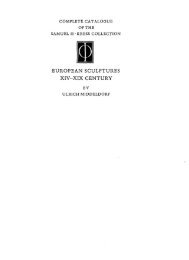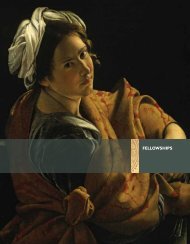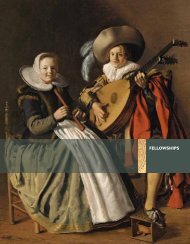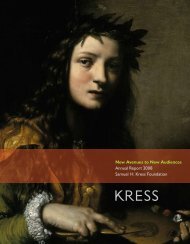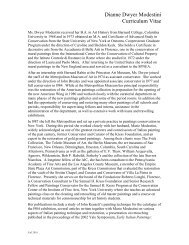The Campus Art Museum - Samuel H. Kress Foundation
The Campus Art Museum - Samuel H. Kress Foundation
The Campus Art Museum - Samuel H. Kress Foundation
Create successful ePaper yourself
Turn your PDF publications into a flip-book with our unique Google optimized e-Paper software.
Institutional commitment to the arts appears to be more recent at sites in<br />
the study with museums established since the 1950s. For example, although the<br />
University of Chicago (UC) “has a strong humanities core” (intern) and is wellknown<br />
as intellectually rigorous, an emphasis on the arts as part of what the<br />
university has to offer is fairly recent and due, in large part to a new president<br />
who took a strong interest in the arts after commissioned research suggested its<br />
importance in attracting gifted high school students. (See Appendix IV.A. for an<br />
interpretive distillation of this and other interviews.)<br />
That changes in perspectives and institutional emphases are possible may<br />
give some solace to other campus museums. <strong>The</strong> UAMA, for example, is dealing<br />
with the most severe budget cuts of any museum in the study. <strong>The</strong>se cuts put the<br />
museum and remaining staff under pressure as each person struggles to do more<br />
with fewer resources. Creative and innovative, they find ways to make increased<br />
use of University of Arizona (U of A) students and community docents who are<br />
enthusiastic about and supportive of the museum, as are faculty who use the<br />
museum in classes. <strong>The</strong> budget challenges at the UAMA, however, are augmented<br />
by a university culture that supports science and technology with, as a respondent<br />
stated, “arts and culture, a kind of afterthought.” Various interviewees commented<br />
on this point:<br />
This is a really extraordinary university. Its level of research is so off the charts….<br />
When the administration is trying to sell itself, which it has to do continually with<br />
the legislature, the strength of medicine and science is always at the top of the<br />
list.... When pressed, they can talk eloquently about the importance of the arts<br />
and humanities and social sciences, but the reality is what resonates with the<br />
legislature is high tech, new technology, new discoveries, how that relates to jobs.<br />
(staff, UAMA)<br />
What is scariest, I think, is that people are saying ‘teach your kids math and<br />
science’ but they don’t get that art ties into those in so many ways. (student, U of A)<br />
A culture of commitment to the arts somewhat obviously suggests that<br />
college or university administrators and faculty would be supportive of the<br />
campus art museum. Less apparent is the relevance of a culture of collaborative<br />
and interdisciplinary learning. What connection might institutional emphases on<br />
collaborative and interdisciplinary research and teaching have to appreciation and<br />
use of campus art museums?<br />
History and Culture of Collaborative and Interdisciplinary<br />
Learning<br />
Collaboration and interdisciplinary, cross-disciplinary, or sometimes transdisciplinary,<br />
are current academic buzzwords. Collaborative and cross-disciplinary<br />
approaches are integrated into many of the ten key high-impact educational<br />
practices identified by the Association of American Colleges and Universities (Kuh<br />
Supportive <strong>Campus</strong> Cultures and Structures<br />
10



